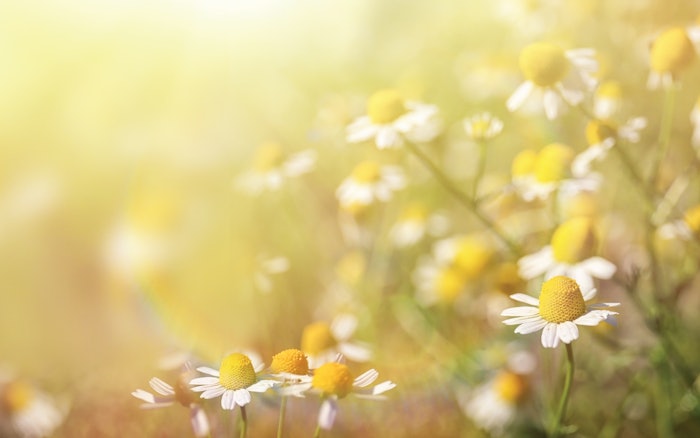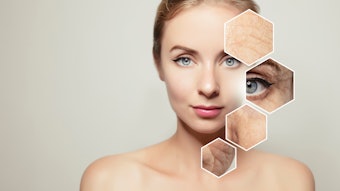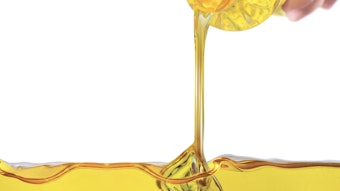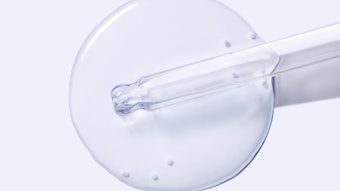
When we hear about chamomile, most often it is related to the tea consumed widely for its ability to calm and induce restful sleep. In fact, did you know that an estimated 1 million cups of chamomile tea are consumed per day?1 Though tea is perhaps the most common use for the chamomile plant, it has tremendous benefit for skin care as an anti-inflammatory agent able to calm the skin, reduce redness and lessen irritation. Grab a cup of the beloved tea, while we explore its source, health uses, skin care applications and use in spa.
Chamomile Basics and History
Chamomile is the common name for a flowering plant from the family Asteracea. The plants in this family are characterized by their flowers resembling daisies, with a defined, circular center and petals around. Indeed, take a look at a chamomile flower, and you will see its likeness to daisies.
Chamomile is an important plant in ancient Chinese, Roman, Greek and Egyptian medicine. In ancient medicine, it was used topically to treat skin injury and inflammation including wounds, eczema, burns and more. It was also taken internally to help with insomnia, reduce anxiety and act as a mild sedative. It is also known to help with digestive ailments such as diarrhea, nausea, vomiting and indigestion.
When it comes to chamomile, the most common types are Roman chamomile (Matricaria recutita) and German chamomile (Chamaemelum nobile). To utilize these plants, the flowers are dried and either made into a powder or used whole.
Chamomile flowers are comprised of flavonoids, terpenes, polysaccharides, coumarins, volatile oils, organic acids and sterols. Flavonoids are the main component of chamomile, with examples being quercetin, apigenin, rutin and luteolin. These flavonoids contribute to the antibacterial and anti-inflammatory properties of the plant. Some of its volitile oils such as isopentyl isobutyrate and isobutyl isobutyrate also contribute to its calming effects The terpene alpha-bisabolol in chamomile also had reported anti-inflammatory properties. There is some research on the market substantiating chamomile's anti-inflammatory benefits. On such study found it to be 60% as effective in treating eczema as hydrocortisone.
In Skin Care and Spa
So, we now know why chamomile is such a beloved ingredient in calming tea, but how is it being used in the skin care industry?
At Highlands Day Spa, it offers a Chamomile & Lavender Treatment Package ($225), where chamomile is incorporated into an exfoliator to polish skin. A lavender body wrap is then applied, followed by a nourishing hair mask and 55 min. massage.
At Manuel Antonio Spa Day, The Radiant Skin & Clarifying (Chamomile) Facial ($125) is designed to soothe, nourish and revitalize skin. In addition to the facial treatment with chamomile, the treatment also includes facial reflexology and aromatherapy to reduce stress and relax muscles around the face.
When it comes to calming chamomile in skin care, it doesn't get much better than Eminence, which created the Calm Skin line featuring the ingredient. In these products--Soothing Chamomile Tonique, Calm Skin Chamomile Cleanser, Calm Skin Chamomile Moisturizer and Calm Skin Chamomile Exfoliating Peel--chamomile is used to calm skin, revitalize skin and balance.
Jurlique also utilizes chamomile in its Calendula Redness Rescue. There, it helps to hydrate and calm. It rebalances dryness and helps to restore skin radiance.
For body treatment, Amber utilizes chamomile in its Marine Algae Body Masque. The algae body masques are formulated to stimulate circulation and cell regeneration. The unique combination of algaes (kelp, spirulina, marine algae and others), essential oils and herbal extracts create two body masque formulations rich in anti-oxidants, vitamins and minerals. The masque can be applied warm or cold.
References
1. https://pmc.ncbi.nlm.nih.gov/articles/PMC2995283
2. https://pmc.ncbi.nlm.nih.gov/articles/PMC9822300












